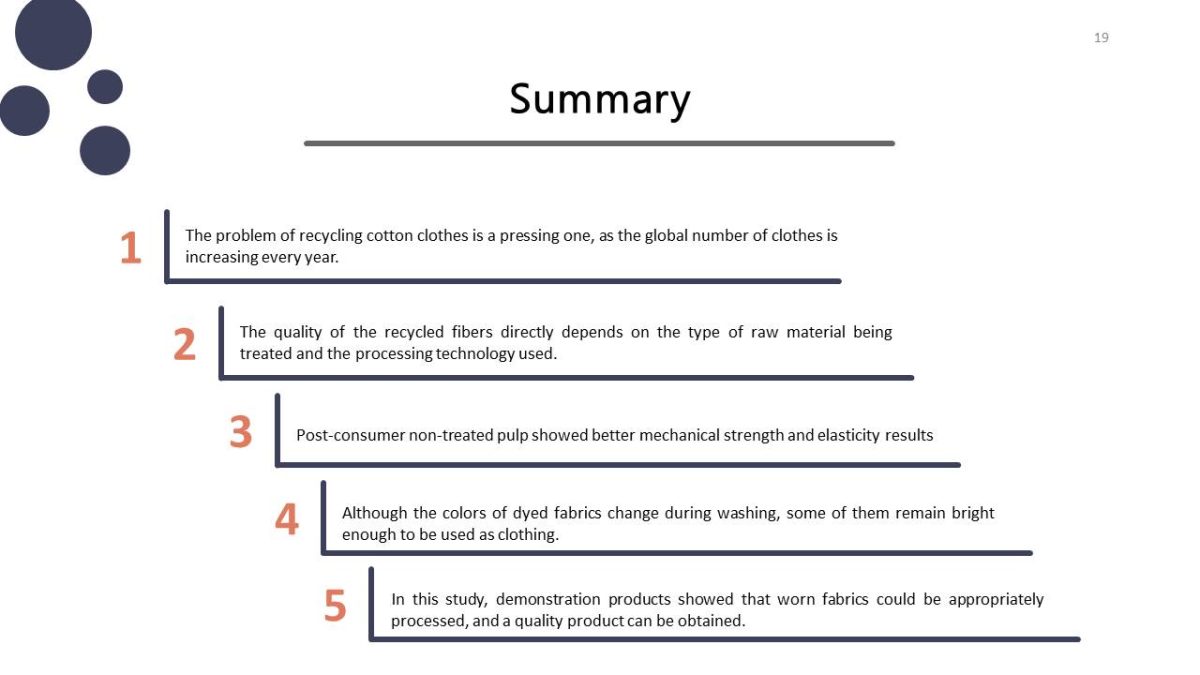Fabric recycling: environmental collapse
With the development of the textile industry and trends in fast fashion, cotton clothing is no longer a durable item in the consumer’s closet.
Although cotton itself is considered a recyclable resource, its footprint may exceed the effect of polyester due to inadequate management of ecological monitoring.
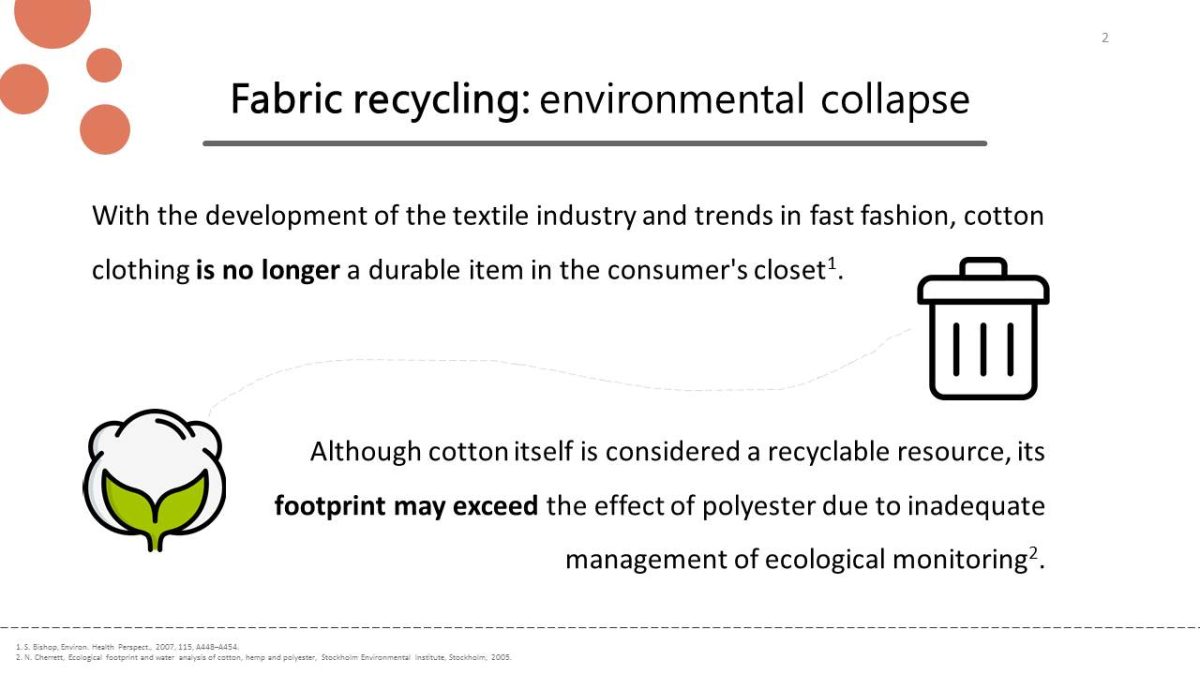
(Frightening) Statistics
- 25% — this is how much cotton is recycled by Europeans.
- 150 liters — this is how much water is needed for dyeing 1 kg of fabric.
- 700 000 tons — this is how many dyes are synthesized all over the world.
- 200 000 tons — such a part of dyes is lost to effluents.
- 75% — this is how much pre-consumer cotton is sent for processing.
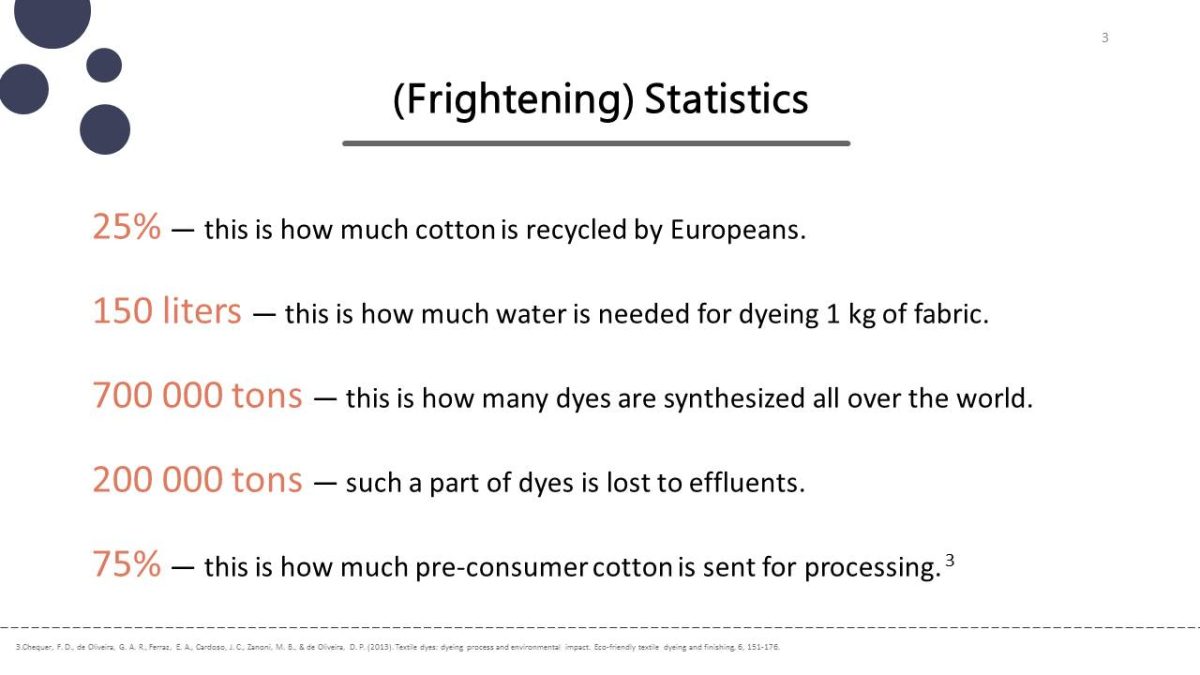
Modern Trends: recycling
Mechanical
Coarse grinding of raw materials, the opening of cotton fibers, spinning. It allows for preserving the color of the product by pre-sorting.
Chemical
More diverse methods based on the technology of full recreation and re-spinning from raw materials. The object of this project.
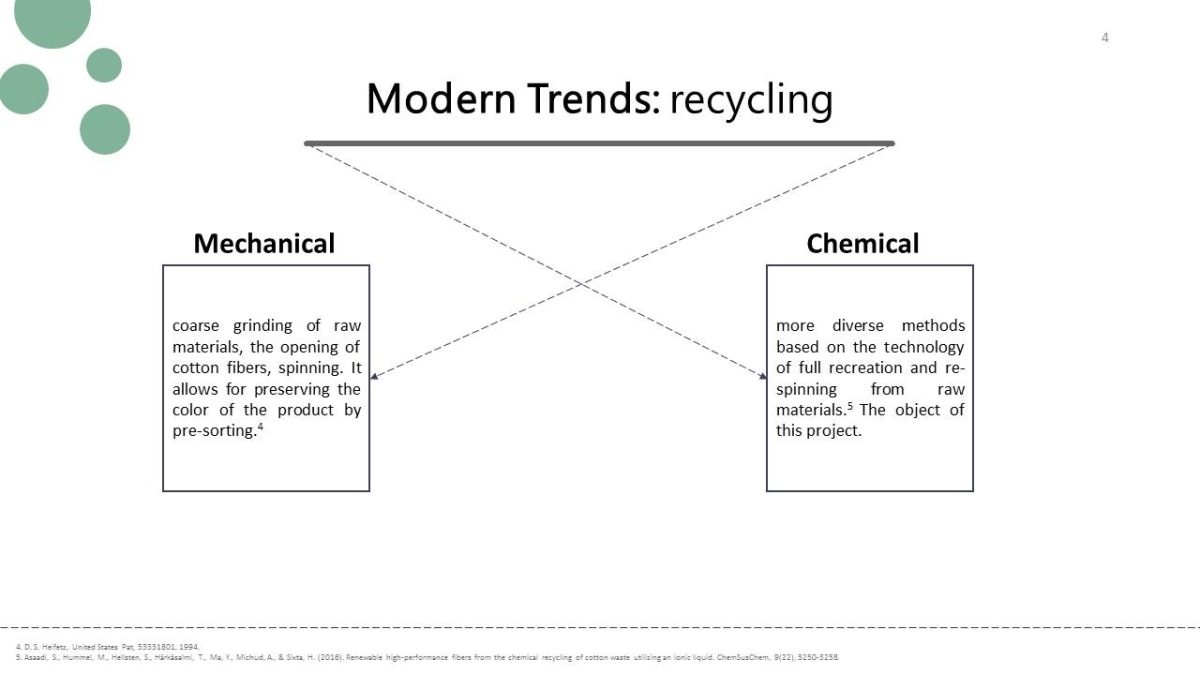
Unsafe Chemical spinning: thesis
The type of raw material determines the quality of the finished product, viscosity, degree of abrasion, and performance characteristics are measured, additional treatment by acid/fermentation hydrolysis to reduce degree of polymerization (DP), cation and metal removal, bleaching, coloration repainting.
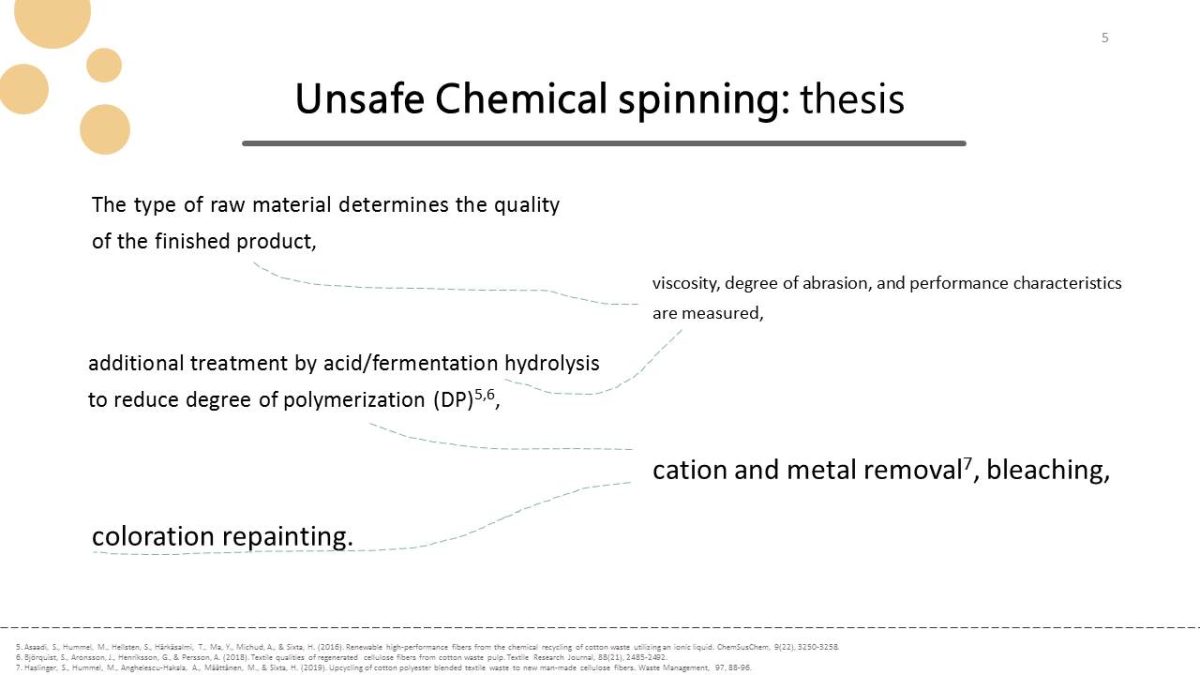
Coloring Requirements
- DYED fabrics can be recycled, but there are too many dyes.
- SYSTEMATIC research is needed.
- THE dyes need to be thermally and chemically resistant.
- DYES should not change the rheological properties of the material.
- STRICT interaction with the substrate.
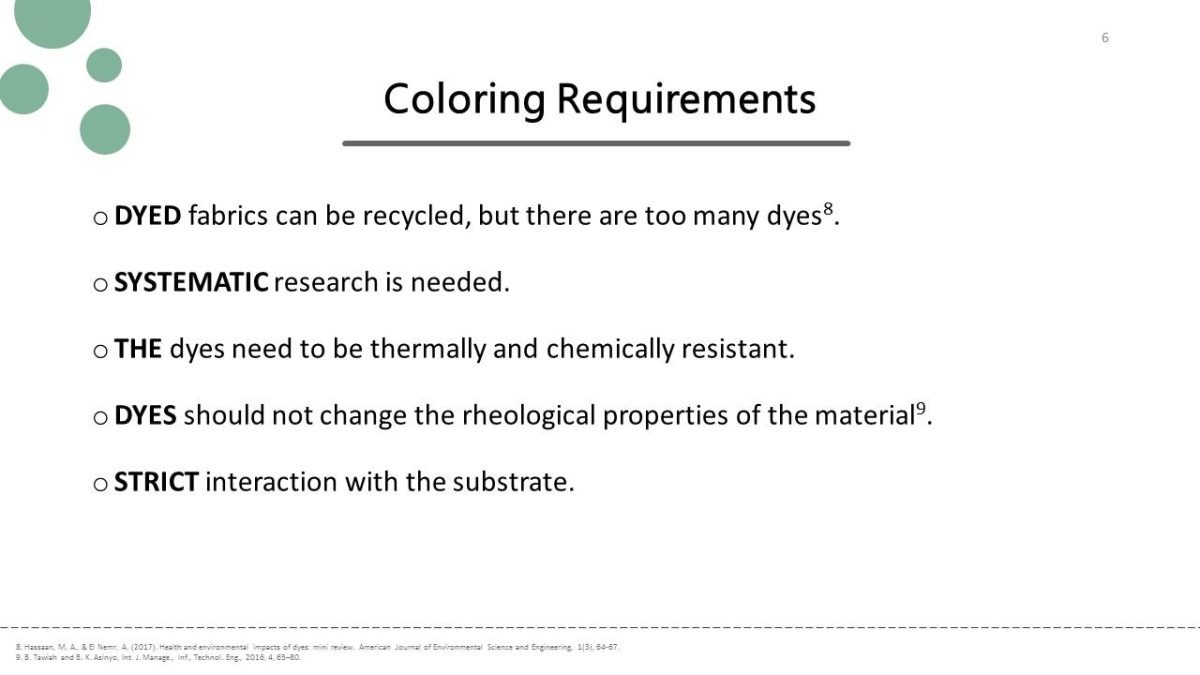
Research: objective and description
Objective: to check if the proposed chemical treatment process can create a dyed cotton fabric suitable for wear.
Description: pre-consumer cotton was irradiated with an electron beam, and then sulfuric acid and endoglucanase were used to give the target degree of polymerization. The spectrum of molar mass distribution was an indicator of pre-treatment. Fibers were spun; mechanical, physical, and chemical were measured. A prototype of clothes from the obtained raw material was developed.
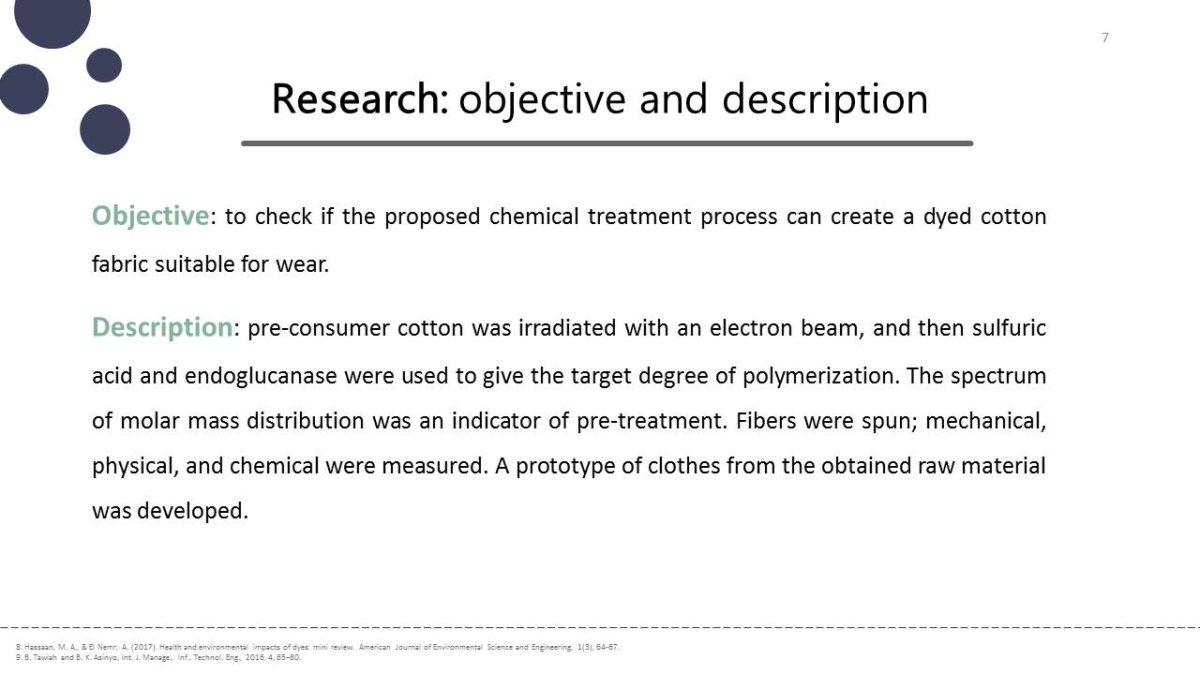
Materials
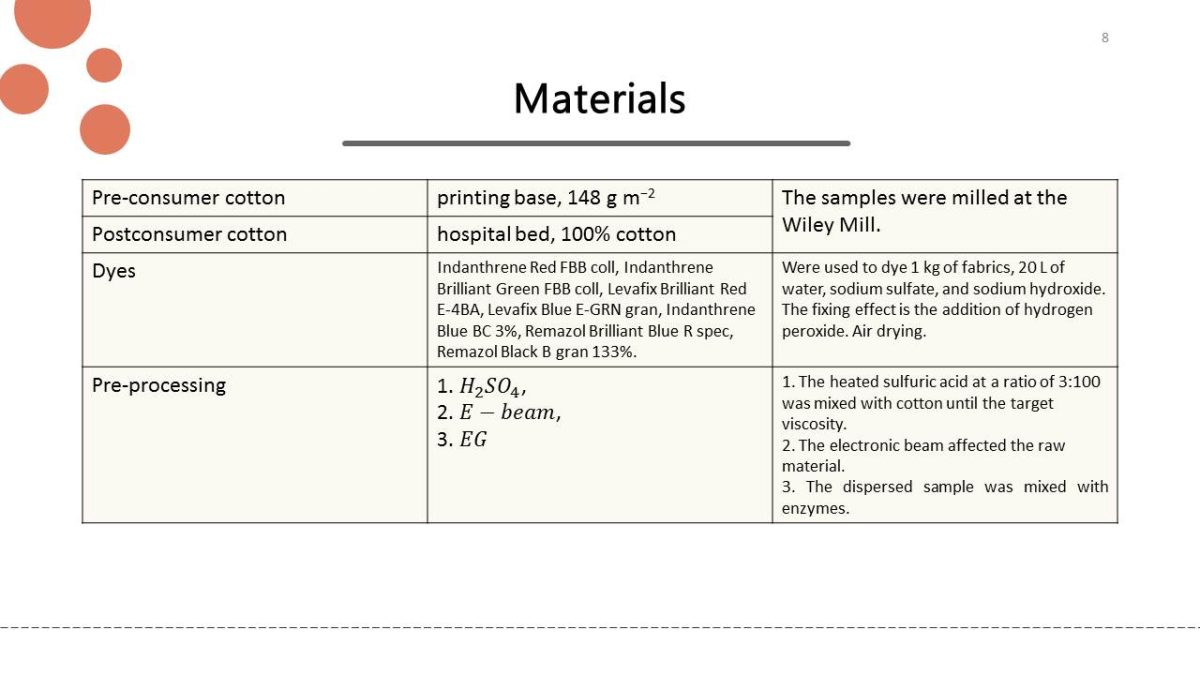
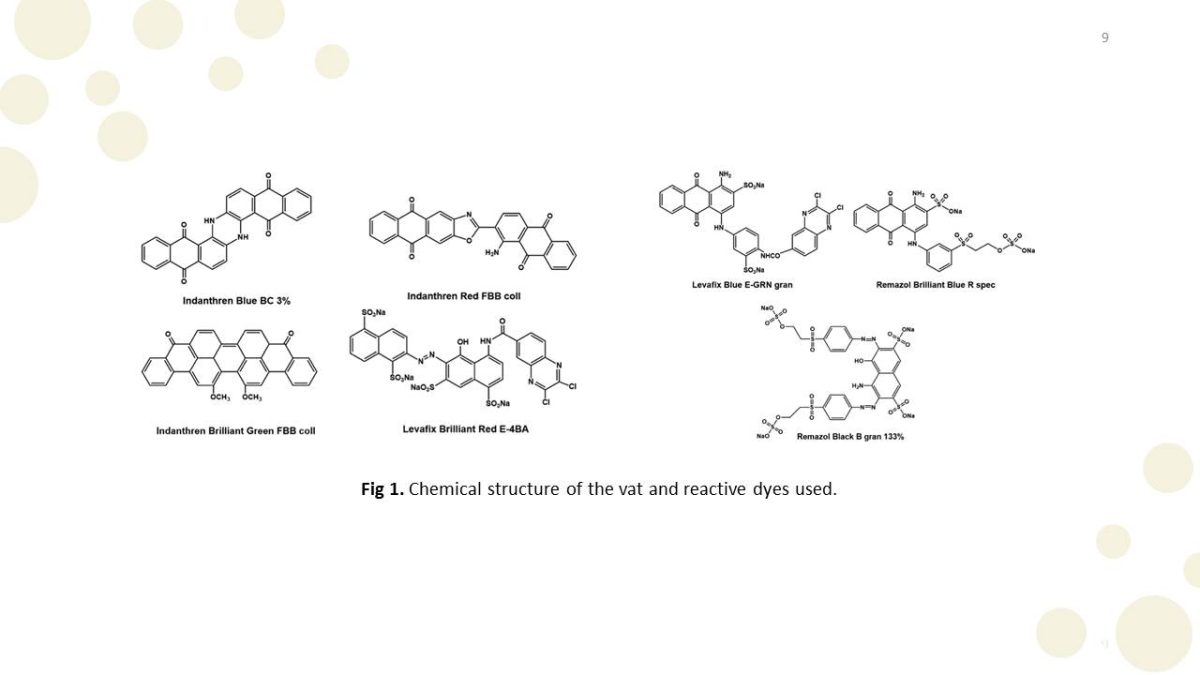
Methods
MMD
Gel permeation chromatography (1 pre-column and 4 analytic) in licl/n,n-dmac.
[DBNH] [OAc]
1,5-diazabicyclo [4.3.0] non-5-ene was neutralized with glacial acetic acid.
Dissolution
Dyes was suspended in [DBNH] [OAC]; microscopic analysis: visual evaluation of dissolubility.
Rheology
Ground fabrics were dissolved in [DBNH] [OAC], press filtration; evaluation and control of viscoelastic properties by a dynamic frequency sweep test.
Spinning
Dissolved cellulose was curled into threads, extruded through pores. Stretching with a drawing factor of 12.
Properties
Measured tenacity, elongation at break, linear density, Young’s Modulus, fiber orientation, birefringence angle.
Color
Evaluation of optical properties. Color difference: ∆E=√((∆L^∗ )^2 〖+(∆a^∗ )〗^2+(∆b^∗ )^2 )
Products
Child’s jacket: yarn + Indanthrene Blue BC 3%. Different technologies of weaving cuffs and the base fabric. No finishing work has been done. Scarf: yarn + Remazol Brilliant Blue R spec.
Wash Fastness
Standard: EN ISO 105-C06. 40×100 mm samples were washed with a detergent solution. Color dynamics were evaluated using grey scales (5 – without color change, 1 – worst).
Rubbing
Standard: EN ISO 105-X12:2016. The samples have been rubbed 20 times with dry and wet cloth. Color dynamics were evaluated using grey scales.
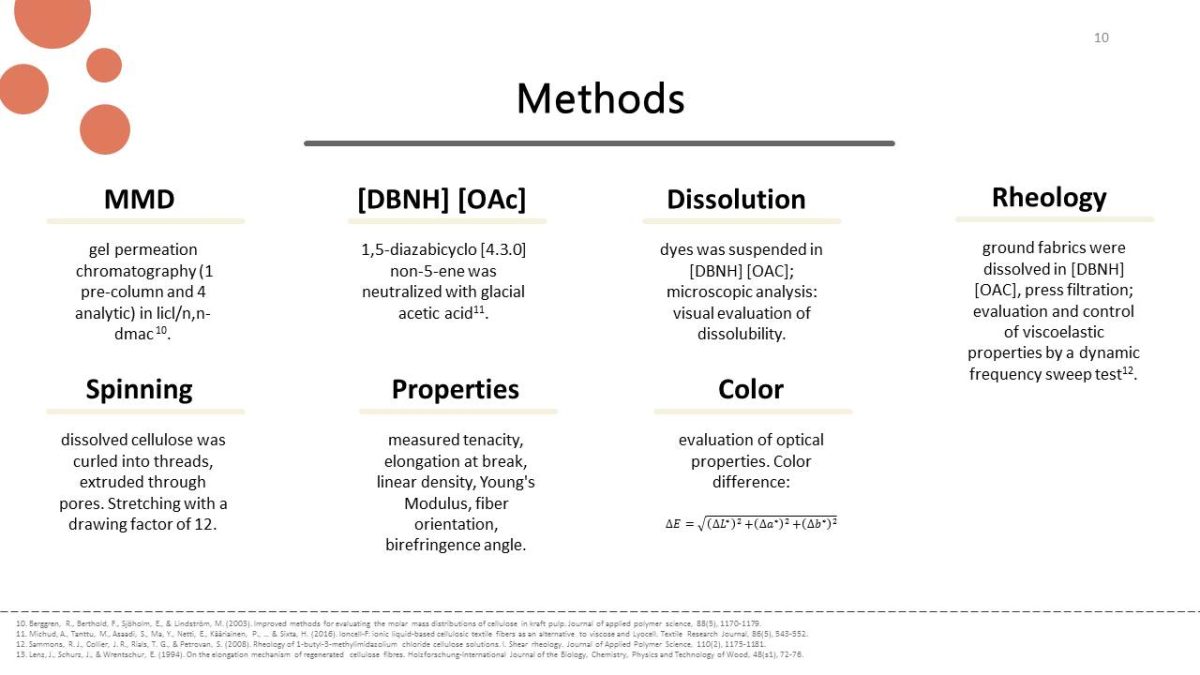

General Results
- The type of raw material directly affects the viscoelastic and mechanical properties of the product.
- The degree of wear affects the viscosity and degree of polymerization: the longer the clothes were in use, the lower the cotton’s viscosity.
- Chemical processing has replaced the need for mechanical abrasion of fabrics, which could lead to undesirable bleaching of raw materials.
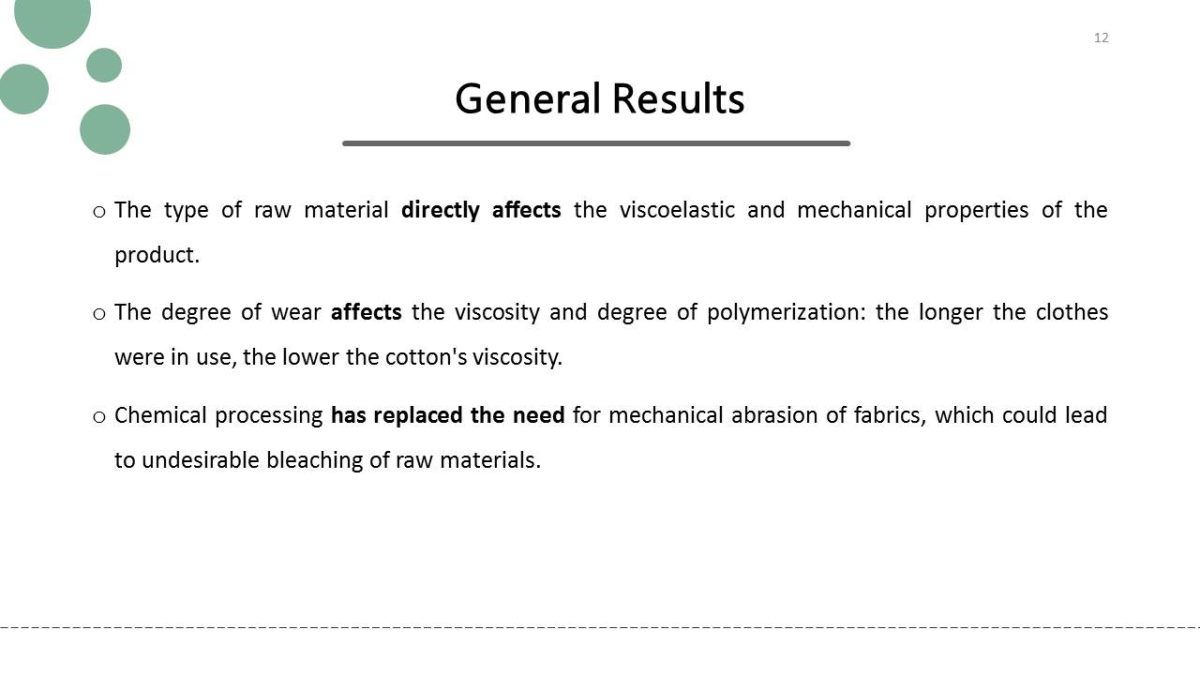

Specific Results
- The acid treatment destroys the cellulose, and enzyme treatment leads to a broader spectrum of molar mass distribution.
- The combination of the two types of hydrolysis can be useful for economic reasons or metal removal.
- E-beam treatment saves time and costs for drying materials.
- EG increases the low molecular weight fractions of the substrate, while acid and e-beam increase the long-chain fragments.
- Reactive dyes, Remazol Black B gran 133% and Levafix Brilliant Red E-4BA, result in ahigher proportion of high-molecular-weight fractions.
- Pre- and postconsumer cotton fabrics require different processing conditions since they do not meet the conditions of Cox-Merz: a possible cause, the difference in the distribution of molar masses.
- Almost all dyes, except for Levafix Brilliant Red E-4BA, showed 34%–49% yield of fibers from raw materials.
- Untreated cellulose dissolved better than treated pulp as there was no stage of chemical cornification and subsequent drying.
- The tensile strength and elongation of postconsumer cotton were higher than that of pre-consumer one.
- The same goes for the strength and flexibility of the fibers: the postconsumer is better.
- The dyes and cellulose formed a homogeneous solution, and only Remazol dyes were leached during washing, which is due to the weak bond with the fiber.

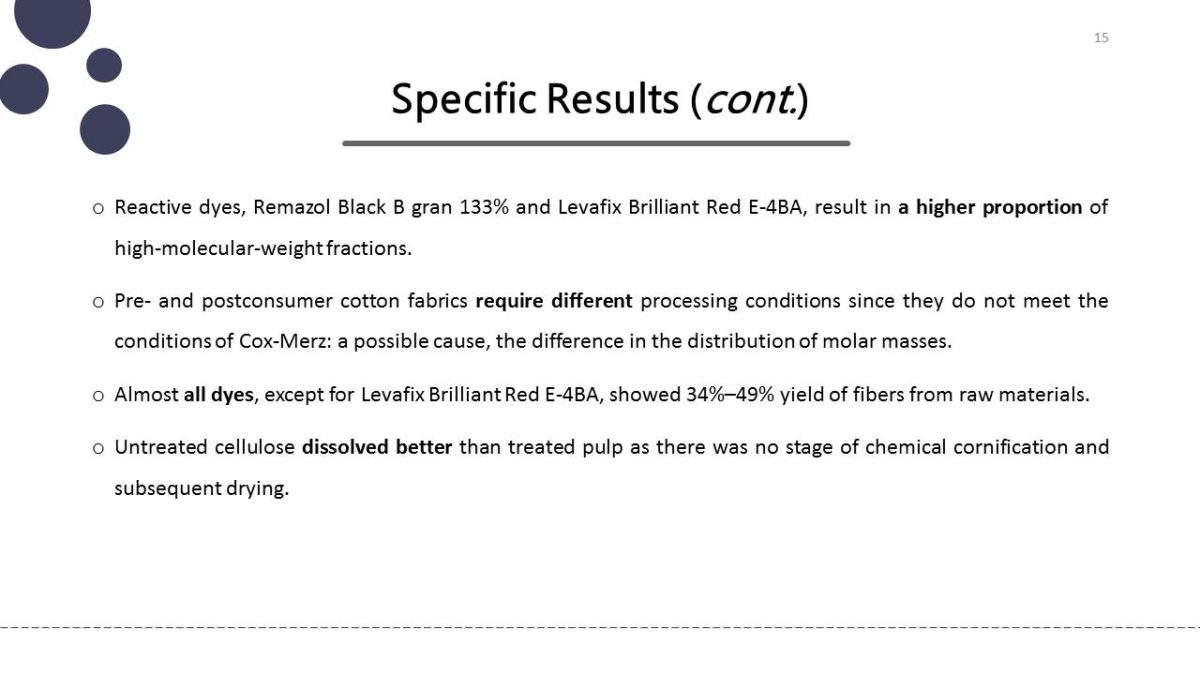
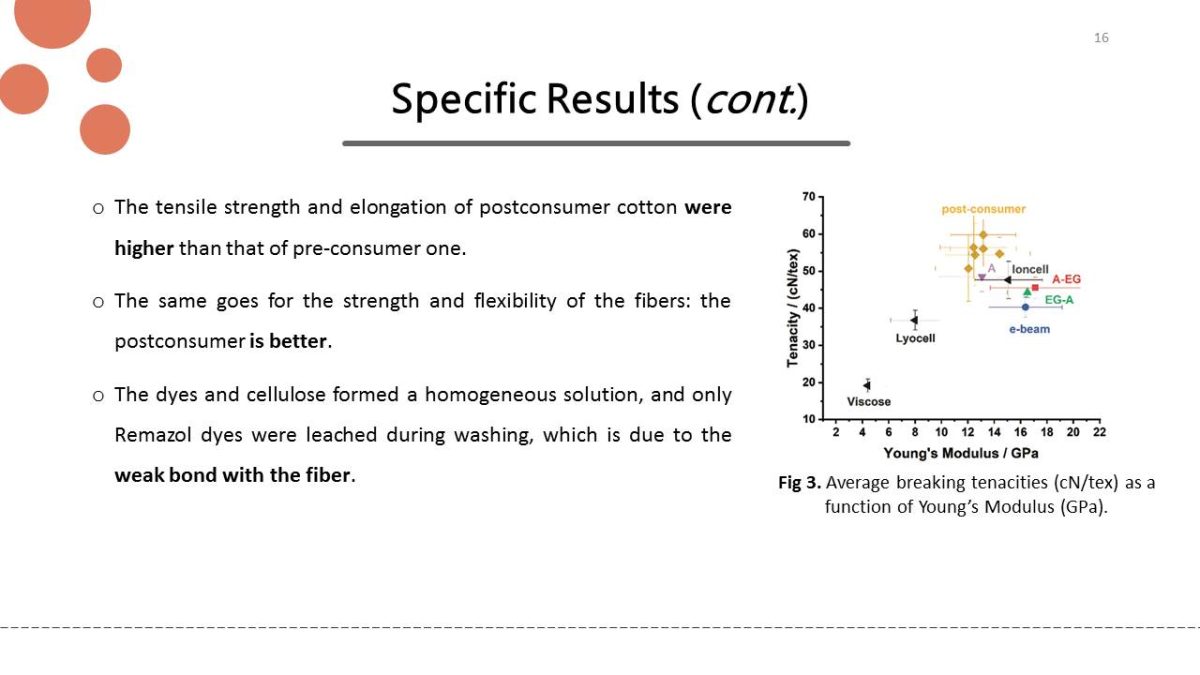

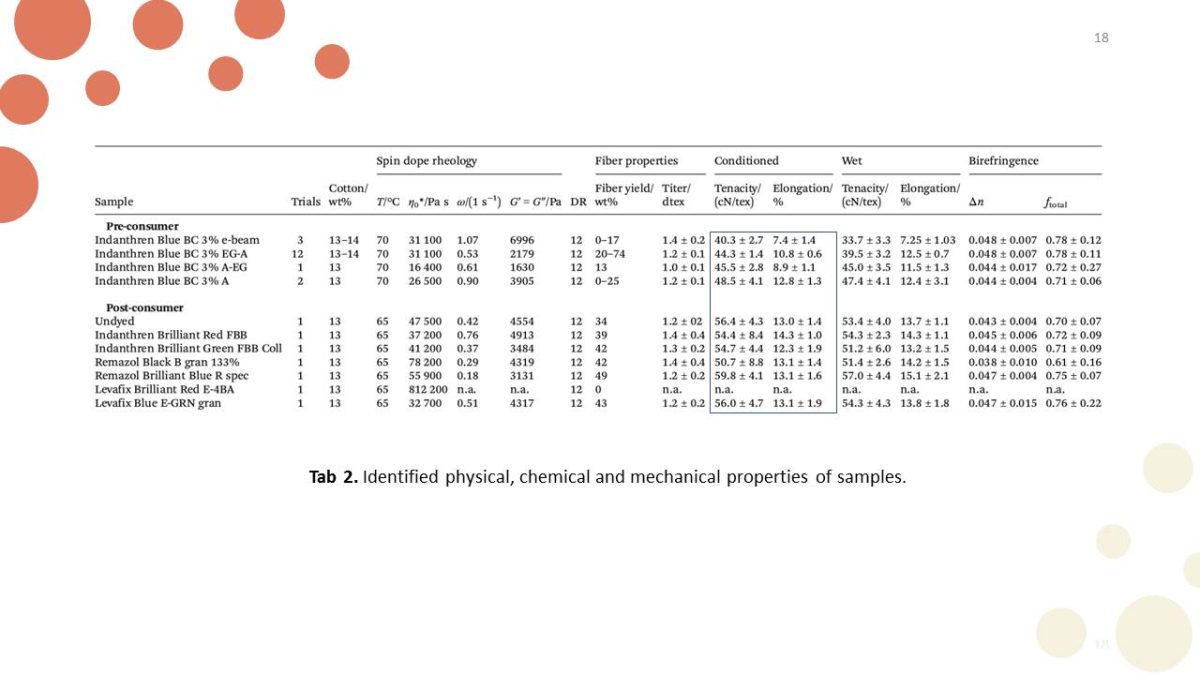
Summary
- The problem of recycling cotton clothes is a pressing one, as the global number of clothes is increasing every year.
- The quality of the recycled fibers directly depends on the type of raw material being treated and the processing technology used.
- Post-consumer non-treated pulp showed better mechanical strength and elasticity results.
- Although the colors of dyed fabrics change during washing, some of them remain bright enough to be used as clothing.
- In this study, demonstration products showed that worn fabrics could be appropriately processed, and a quality product can be obtained.
